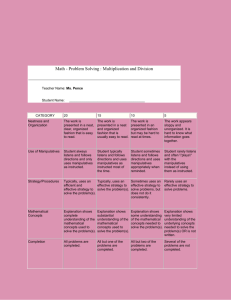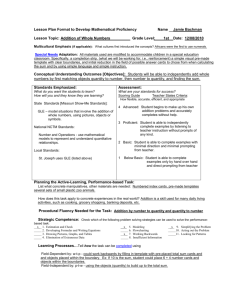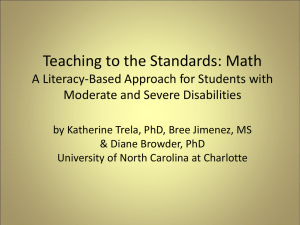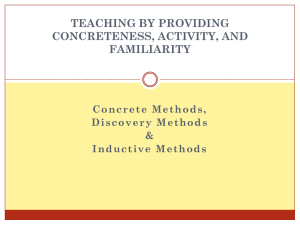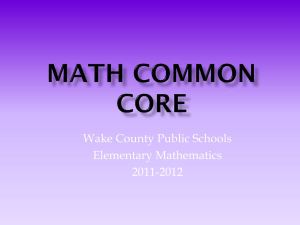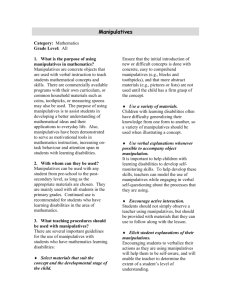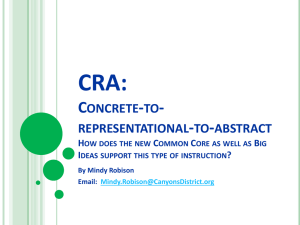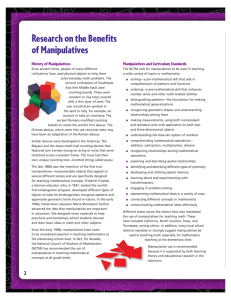Follow Through: Four important levels when using
advertisement
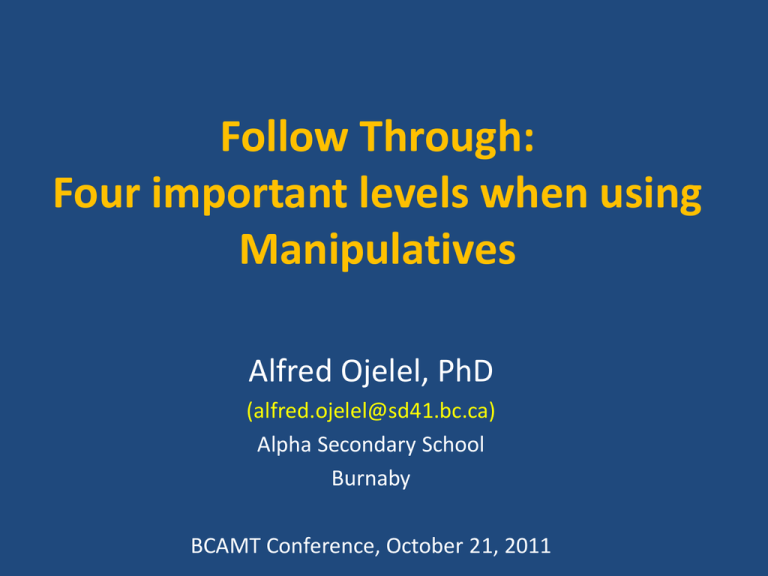
Follow Through: Four important levels when using Manipulatives Alfred Ojelel, PhD (alfred.ojelel@sd41.bc.ca) Alpha Secondary School Burnaby BCAMT Conference, October 21, 2011 Consider this sequence . . . Head down Knees bent Keep your arms straight Follow through We’ve all heard it but it is doing it that matters! The objective of this sequence in a golf swing of any shape, clearly, is to consistently get the golf ball airborne. Manipulatives • Any tangible object, tool, model, or mechanism that may be used to clearly demonstrate (introduce, practice, or remediate) a depth of understanding, while problem solving, about a specified mathematical concept or concepts. • We find manipulatives in most classrooms now: buckets of pattern blocks; trays of tiles and cubes; and collections of geoboards, tangrams, counters, spinners . . . • They are being touted as a way to help students learn math more easily. But many teachers still ask . . . • Are manipulatives a fad, a craze, a rage? • How do I fit them into my instruction? • How often should I use manipulatives? • How do I make sure students see them as learning tools, not toys? • Are they useful for upper-grade students, too? Why are manipulatives important? • Research based studies show that, with manipulatives, students: – develop more precise and more comprehensive mental representations, – often show more motivation and on-task behaviour, – understand mathematical ideas, and better apply these ideas to life situations. • According to learning theory (based on Jean Piaget's research), children are active learners who master concepts by progressing through three levels of knowledge : – concrete, – pictorial, and – symbolic. • Piaget (1965) approached the construction of knowledge through questioning and building on learner’s answers while they constructed knowledge, • Vygotsky (1962) felt that learners could be guided to stronger mathematical understandings as they progressively analyzed complex skills on their own with the teacher nearby to scaffold or facilitate as needed. We can deduce then that . . . • Manipulatives enable students to explore concepts at the concrete level of understanding. • When students manipulate objects, they are taking the necessary first steps toward building understanding and internalizing math processes and procedures. • For a learner to understand and handle a concept at the abstract or symbolic level successfully, he or she must first understand the concept at the other two levels, in the order given - concrete then pictorial. • When students demonstrate understanding at the concrete level then they are ready to move to the next level. • They can then apply their knowledge using representations of the objects in place of the objects themselves. Concrete to Concrete exploration • Instruction proceeds through a sequence with each concept first modeled with concrete materials e.g. red and yellow chips. • The materials by themselves are not enough. Teacher guidance is essential. – How did you make this model? – What did you show? • We should try to "get inside students' heads" as they work with concrete materials to solve a problem by asking questions that elicit their thinking and reasoning: – To can get a better sense of what students know and don't know, – To identify alternate conceptions, thereby – To develop a basis for intervention strategies. Concrete to Abstract Abstract to Concrete (Representational) • The concept is modeled at the semi-concrete level which may involve drawing pictures that represent concrete objects e.g. circles, dots, tallies, . . . – Could you draw this model? – How did you do that? – What did you draw to show groups? – How did you group these? • This representational level affords learners multiple opportunities to construct mathematical knowledge while making reasonable connections to everyday tasks. • This is the essence of tool- and problem-based teaching and learning. • This level is the real bridge between the concrete and abstract. Abstract to Abstract • Here the concept is modeled at the abstract (symbolic) level using only numbers, notation, and mathematical symbols – What numbers, operations, expressions . . . did you use to show this problem? – Is this answer a reasonable number? Follow the sequence through . . . C C A A C A C A How can we make this happen? 1. Clearly set and maintain behaviour standards for manipulatives. 2. Clearly state and set the purpose of the manipulative within the mathematics lesson. 3. Facilitate cooperative and partner work to enhance mathematics language development. 4. Allow students an introductory timeframe for free exploration. 5. Model manipulatives clearly and often. 6. Incorporate a variety of ways to use each manipulative. 7. Support and respect manipulative use by all students. 8. Make manipulatives available and accessible. 9. Support risk-taking and inventiveness in both students and colleagues. 10.Establish a performance-based assessment process. Example of exploration sequence Thank you. Comments, suggestions, questions may be directed to alfred.ojelel@sd41.bc.ca
